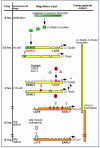Temporal regulation of the muscle gene cascade by Macho1 and Tbx6 transcription factors in Ciona intestinalis
- PMID: 20592183
- PMCID: PMC2894658
- DOI: 10.1242/jcs.066910
Temporal regulation of the muscle gene cascade by Macho1 and Tbx6 transcription factors in Ciona intestinalis
Abstract
For over a century, muscle formation in the ascidian embryo has been representative of 'mosaic' development. The molecular basis of muscle-fate predetermination has been partly elucidated with the discovery of Macho1, a maternal zinc-finger transcription factor necessary and sufficient for primary muscle development, and of its transcriptional intermediaries Tbx6b and Tbx6c. However, the molecular mechanisms by which the maternal information is decoded by cis-regulatory modules (CRMs) associated with muscle transcription factor and structural genes, and the ways by which a seamless transition from maternal to zygotic transcription is ensured, are still mostly unclear. By combining misexpression assays with CRM analyses, we have identified the mechanisms through which Ciona Macho1 (Ci-Macho1) initiates expression of Ci-Tbx6b and Ci-Tbx6c, and we have unveiled the cross-regulatory interactions between the latter transcription factors. Knowledge acquired from the analysis of the Ci-Tbx6b CRM facilitated both the identification of a related CRM in the Ci-Tbx6c locus and the characterization of two CRMs associated with the structural muscle gene fibrillar collagen 1 (CiFCol1). We use these representative examples to reconstruct how compact CRMs orchestrate the muscle developmental program from pre-localized ooplasmic determinants to differentiated larval muscle in ascidian embryos.
Figures





Similar articles
-
Ci-Tbx6b and Ci-Tbx6c are key mediators of the maternal effect gene Ci-macho1 in muscle cell differentiation in Ciona intestinalis embryos.Dev Biol. 2005 Jun 15;282(2):535-49. doi: 10.1016/j.ydbio.2005.03.029. Dev Biol. 2005. PMID: 15950616
-
Identification of downstream genes of the ascidian muscle determinant gene Ci-macho1.Dev Biol. 2004 Oct 15;274(2):478-89. doi: 10.1016/j.ydbio.2004.07.013. Dev Biol. 2004. PMID: 15385173
-
macho-1-Related genes in Ciona embryos.Dev Genes Evol. 2002 Mar;212(2):87-92. doi: 10.1007/s00427-002-0218-3. Epub 2002 Feb 28. Dev Genes Evol. 2002. PMID: 11914940
-
Gene-regulatory networks in the Ciona embryos.Brief Funct Genomic Proteomic. 2009 Jul;8(4):250-5. doi: 10.1093/bfgp/elp018. Epub 2009 Jun 17. Brief Funct Genomic Proteomic. 2009. PMID: 19535506 Review.
-
A gene regulatory network for cell fate specification in Ciona embryos.Curr Top Dev Biol. 2020;139:1-33. doi: 10.1016/bs.ctdb.2020.01.001. Epub 2020 May 5. Curr Top Dev Biol. 2020. PMID: 32450958 Review.
Cited by
-
Modular co-option of cardiopharyngeal genes during non-embryonic myogenesis.Evodevo. 2019 Mar 5;10:3. doi: 10.1186/s13227-019-0116-7. eCollection 2019. Evodevo. 2019. PMID: 30867897 Free PMC article.
-
Cereblon influences the timing of muscle differentiation in Ciona tadpoles.Proc Natl Acad Sci U S A. 2023 Oct 24;120(43):e2309989120. doi: 10.1073/pnas.2309989120. Epub 2023 Oct 19. Proc Natl Acad Sci U S A. 2023. PMID: 37856545 Free PMC article.
-
Brachyury controls Ciona notochord fate as part of a feed-forward network.Development. 2021 Feb 5;148(3):dev195230. doi: 10.1242/dev.195230. Development. 2021. PMID: 33419874 Free PMC article.
-
From notochord formation to hereditary chordoma: the many roles of Brachyury.Biomed Res Int. 2013;2013:826435. doi: 10.1155/2013/826435. Epub 2013 Mar 31. Biomed Res Int. 2013. PMID: 23662285 Free PMC article. Review.
-
Functional Brachyury binding sites establish a temporal read-out of gene expression in the Ciona notochord.PLoS Biol. 2013 Oct;11(10):e1001697. doi: 10.1371/journal.pbio.1001697. Epub 2013 Oct 29. PLoS Biol. 2013. PMID: 24204212 Free PMC article.
References
-
- Aruga J., Kamiya A., Takahashi H., Fujimi T. J., Shimizu Y., Ohkawa K., Yazawa S., Umesono Y., Noguchi H., Shimizu T., et al. (2006). A wide-range phylogenetic analysis of Zic proteins: implications for correlations between protein structure conservation and body plan complexity. Genomics 87, 783-792 - PubMed
-
- Bertrand V., Hudson C., Caillol D., Popovici C., Lemaire P. (2004). Neural tissue in ascidian embryos is induced by FGF9/16/20, acting via a combination of maternal GATA and Ets transcription factors. Cell 115, 615-627 - PubMed
-
- Brown C. D., Johnson D. S., Sidow A. (2007). Functional architecture and evolution of transcriptional elements that drive gene coexpression. Science 317, 1557-1560 - PubMed
-
- Chapman D. L., Papaioannou V. E. (1998). Three neural tubes in mouse embryos with mutations in the T-box gene Tbx6. Nature 391, 695-697 - PubMed
-
- Christiaen L., Stolfi A., Davidson B., Levine M. (2009). Spatio-temporal intersection of Lhx3 and Tbx6 defines the cardiac field through synergistic activation of Mesp. Dev. Biol. 328, 552-560 - PubMed
Publication types
MeSH terms
Substances
Grants and funding
LinkOut - more resources
Full Text Sources

